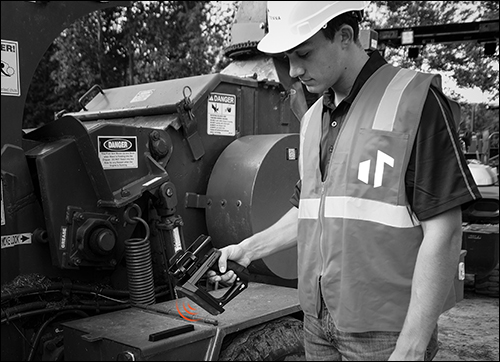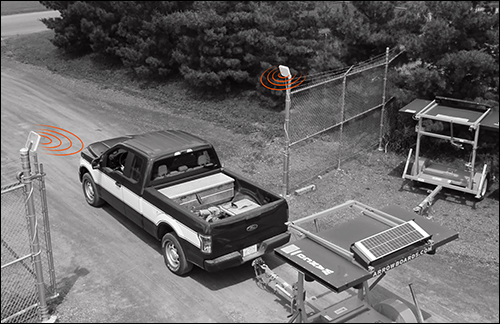BuildSourced, an industrial inventory-management technology company, has launched an updated version of its solution that employs radio frequency identification and other Internet of Things (IoT) technologies to help its customers manage their assets. The firm is doing so under the new name of Tenna.
The two-year-old company, based in Edison, N.J., already offered physical asset-management software solutions for the civil construction industry, but that platform now includes IoT technology as well. That, says CEO and co-founder Austin Conti, positions the company as a leader in the industrial sector to offer an end-to-end equipment-management solution. The company is offering passive UHF RFID functionality now, with a branded tracker device for LoRa, active RFID, cellular and Bluetooth Low Energy (BLE) tracking expected to be available by the end of the year. Several construction companies have been trialing the RFID- and tracker-based systems at their own sites for the past three months.

Conti has a background in the civil construction industry. He and co-founder Jose Cueva launched BuildSourced in 2015 as a way to manage the variety of assets used on a typical worksite. He recalls working on a bridge project with Cueva when the two started brainstorming about creating a better solution to sourcing and management materials. At most projects, Conti explains, a project or equipment manager is responsible for managing what equipment is onsite, ensuring it doesn’t go missing and billing for it as needed. This can be a time-consuming task.
There are software-, RFID- and IoT-based solutions for such applications, Conti says, but the primary problem the construction and other industries face is the lack of a single, unified platform approach to tracking all equipment and inventory assets. The BuildSourced platform addressed that with a solution aimed at identifying the location of and status of every piece of equipment used on a site, ranging from hand tools to heavy equipment and vehicles.
The first version of the solution utilized QR codes to help personnel on worksites identify the objects being managed. However, Conti says, from the onset, the company had long-term plans to automate that data and create a single IoT-based solution. That led to the new Tenna sensor-based products, with a single solution “built so that they could capture meta data,” says Michael Cook, Tenna’s CTO. That data, he notes, can include not only the unique identifier, but information about a particular piece of equipment, such as how long or how often it was used, as well as its inspection or maintenance history.
The new Tenna product line uses BLE, GPS, cellular and LoRa technology while separate UHF RFID transponders can be used with the system. In the latter case, the UHF RFID tags transmit to fixed and handheld readers which send location data based on each read event to the company’s asset-management software platform. By early 2018, the company expects to be selling its Asset Trackers, which come with UHF RFID transponders as well as active RFID, BLE, GPS, cellular and LoRa functionality. The trackers can be attached to a tool, machine or vehicle.
The company’s goal, Conti says, “is to take the challenge out of delivering construction projects on time and cost-effectively,” with the technology that helps them manage the materials that they need and that the bill for, both onsite and off. Several construction firms are currently piloting the technology by tracking tagged items as they pass through gates at the entrance and exit of their worksites, as well as monitoring the real-time locations of items within parts of the sites.
Approximately 70 percent of Tenna’s existing customers have expressed an interest in upgrading their solution to include the RFID and other IoT-based data. Most are construction companies; however, the solution is also designed for the oil and gas, manufacturing and agricultural markets.

For each project, Tenna works with the customer to design a system that suits their specific requirements, which can consist of a variety of technologies. For instance, passive RFID tags can enable the tracking of goods through gates or being interrogated via a handheld reader, while the Asset Tracker provides more real-time data as well as sensor data.
First, the company reports, a passive RFID tag can be attached to anything from a screwdriver to a crane. Fixed readers and antennas could then be attached at entrances and exits. Each time an item passes the reader, the unique ID number of that object is captured and forwarded to the Tenna software, thereby indicating that it has entered or left a specific site.
If items are being inspected or maintained, their tags could be read using a handheld interrogator. Users would simply read each tag, enter such data as what service they are conducting, take a picture of the item if needed, input details about its condition, and pair that information with the location via the user’s GPS data on his or her handheld reader. The system can also include RFID-enabled badges that workers wear, which can be read to update their own location or status with specific inventory. This, for instance, would enable workers to borrow specific tools or equipment and be linked to those items as they were being used.
The software can not only store and analyze data about where the items are located, but also track how long an asset has been in use, based on its location or status. This can help to automate the scheduling of maintenance or inspection. In addition, the system can track whether an item has been properly inspected and alert a worker in the event that he or she sread the tag of an item requiring inspection prior to reuse.
The software can also automate the billing process, the company reports. For instance, if a piece of equipment is used at a specific worksite and its use is billed to the project’s owner, the system can track how long that item remains at that site, as well as when it leaves, which could prompt the release of an invoice to the customer. If managers need to access the closest piece of equipment to a project where it is required, they can view where that specific piece of equipment was last located, based on an RFID tag read.
The Asset Tracker brings additional functionality beyond that of passive RFID. It comes with a built-in accelerometer and temperature sensor, as well as Wi-Fi and cellular functionality and a BLE beacon. The tracker—which is about the size of a dollar bill and as thick as a typical paperback book—is designed to be durable. It is encased in fiberglass and reinforced nylon and can be attached to items via wire ties, epoxy adhesive, magnets, bolts or screws.
A built-in battery powers the tracker for approximately five to ten years when the device is set to transmit a signal eight times a day, every day. Another version of the tracker can draw power from the device to which it is attached, such as a vehicle or other powered equipment.
The BLE radio built into the tracker can emit a unique ID via a Bluetooth connection, which can be captured with a user’s BLE-based smartphone or other device. The device can then forward that data to the cloud-based server, where software tracks the user’s inventory. The cellular service enables the tracker to forward sensor data via LTE Cat M1 to cellular networks. With LoRa, users can set up their own private network to track the movements of tracker-tagged devices at long range.
The pilots, to date, are proving that the technology works in the construction industry. Cook says the company expects to market the system for other vertical markets that need to track equipment around worksites, assembly floors or storage yards. While technology companies offer a variety of IoT- and RFID-based solutions, he adds, the Tenna system is unique because it is designed to suit the needs of any customer, tailored to its application.
Tenna’s goal, Conti says, is to solve the age-old problems of construction sites or equipment managers using technology. “This is an exciting time in construction,” Conti states, “because so much of their work is going digital.”



